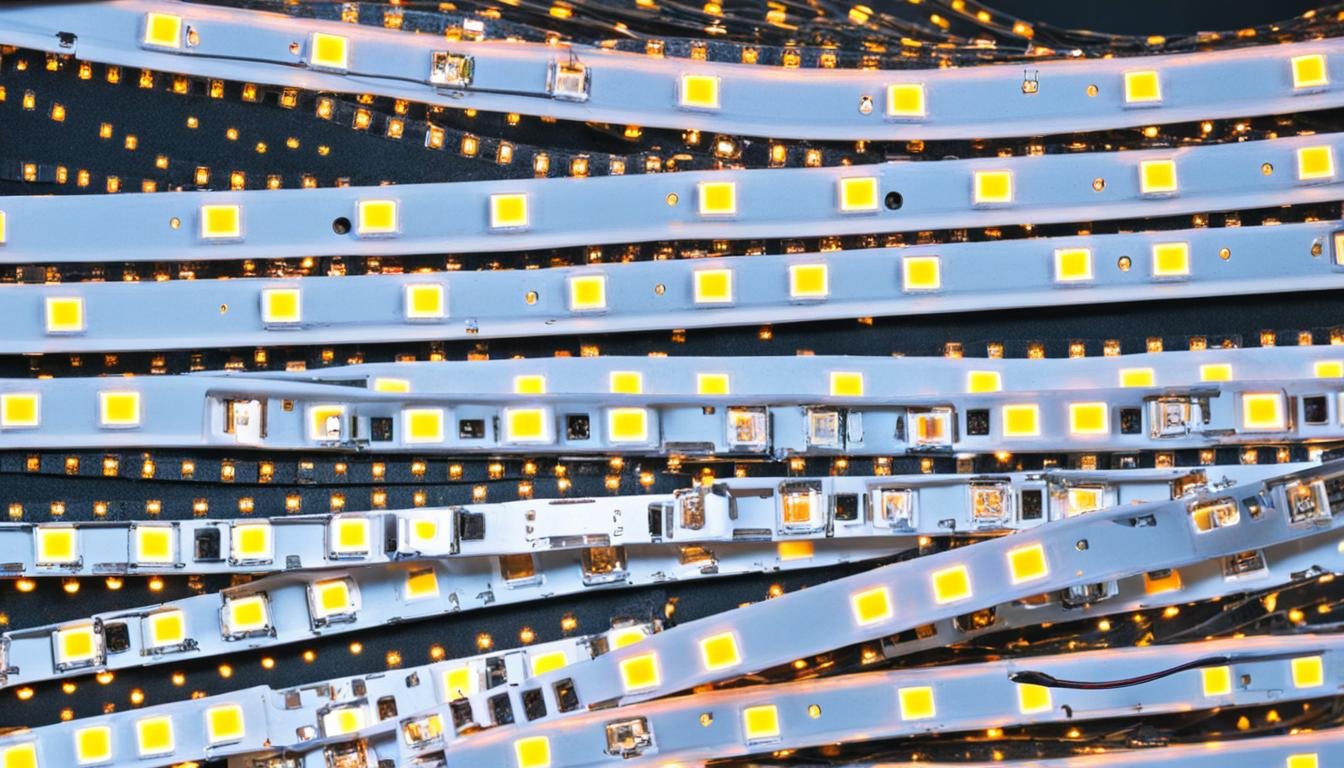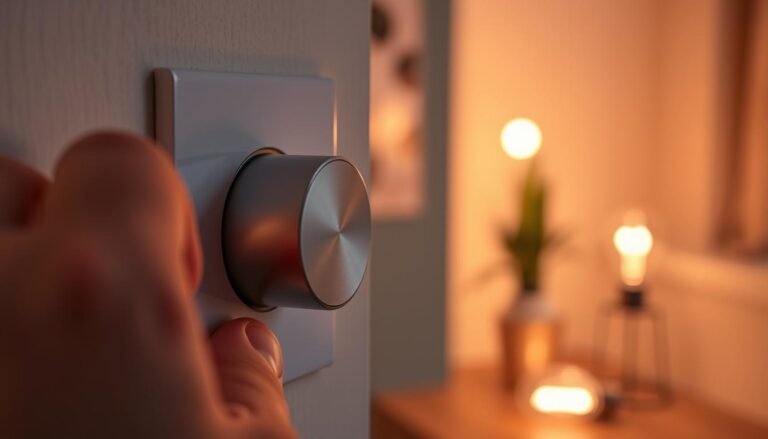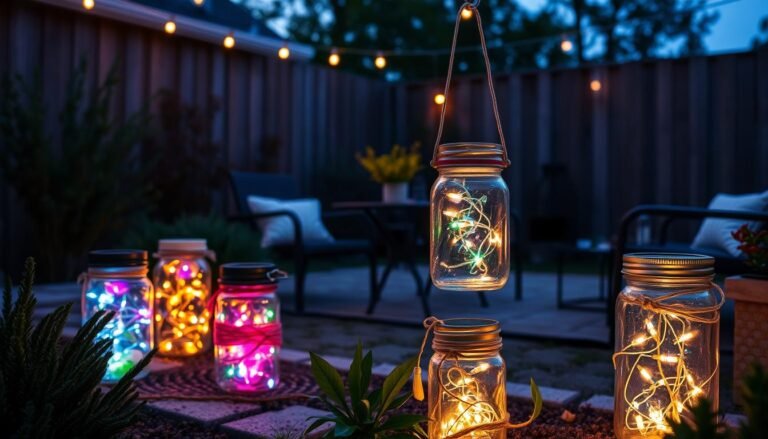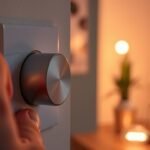Affiliate Disclosure: This post may contain affiliate links. If you make a purchase, we may earn a small commission at no extra cost to you.
Are your LED strip lights always needing fixing? The key to good lighting is the right setup. But are you sure you’re doing it the best way? This guide will help you how to connect led strip lights from start to finish, picking the best items, installing correctly, and fixing any issues.

LED Strip Light Installation Essentials
Tools and Materials Needed
You’ll need the LED strip lights themselves, found in different sizes and colors. Some top brands are Govee, Philips Hue, and Micomlan. You’ll also require items like a measuring tape, scissors, and a cleaning cloth. Don’t forget a ladder or step ladder if it’s hard to reach. And you might need adhesive strips or double-sided tape.
Choosing the Right LED Strip Lights
When picking LEDs, focus on voltage, power use, brightness, and color. This helps your setup run smoothly. For example, Luma5 is good for general lighting as it’s energy efficient. COB lights, being 24V, are perfect for focused light such as under cabinets.1 The wire gauge you choose is important too, with thinner wires for some models and thicker for others.
How to Connect LED Strip Lights
Measuring and Trimming the LED Strip
Measure the space and the LED strip to see if it fits. Trim the strip if it’s too long, using the cut points marked on it.
Surface Preparation
Clean the area well before sticking the lights. Use a degreasing solution to make sure it’s really clean. This helps the strip lights stay put.
Applying the LED Strip Lights
Now, stick the lights on. Start peeling and pressing from one end, making sure they go on straight. Do this slowly and carefully.
Connecting Multiple LED Strips
Using LED Strip Connectors
For more coverage or special patterns, join LED strips with connectors. These come in different types for various needs. To connect, just slide the cut end of one strip into the connector, then add the next strip. Make sure they’re well connected.
Powering Your LED Strip Lights
Determining Voltage Requirements
Getting the right power is vital for your LED lights to work well. First, know if your strips need 12V or 24V.1
Calculating Power Consumption
Next, find out how much power your lights use to select the right supply. Multiply the wattage by the length, then add 20% for safety.1
Selecting the Right Power Supply
Choose a power supply that meets your strips’ voltage and amperage needs. This makes sure they work smoothly. The 80/30 Rule helps you pick the right one.1
Conclusion
Connecting LED strip lights the correct way is important and can be done right. By using the tools and knowledge from this guide, you’ll have great lighting. Whether it’s for your kitchen, stairs, or a unique home design, LED strips are versatile and efficient. With good prep and care, you’ll light up your space for years.
Key Takeaways
- Properly connecting LED strip lights is essential for a seamless and long-lasting lighting experience.
- Consider voltage requirements, power consumption, and desired brightness and color temperature when choosing LED strip lights.
- Measure, trim, and prepare the surface before applying LED strip lights for a secure and clean installation.
- Use LED strip connectors to link multiple strips and create custom lighting patterns.
- Ensure the power supply matches the voltage and amperage requirements of your LED strips for optimal performance.
LED Strip Light Installation Essentials
When setting up LED strip lights, you need a few key items. First, get your LED strip lights. You can choose from many sizes and colors from options like Govee2, Philips Hue2, and Micomlan2. Next, grab a measuring tape, scissors, and something to clean the surface. This could be a cleaning cloth and a solution to remove any dirt or grease.
You might also require a way to reach high areas, like a ladder. For sticking the lights up, adhesive strips or double-sided tape are handy.
Choosing the Right LED Strip Lights
Choosing LED strip lights means looking at their power needs,2 how much energy they use, and the light they give off. For an easy setup, match the lights to your space in terms of brightness and color. If the lights will be outside or in damp places, pick ones that are waterproof. For a bold look, choose thick LED strips.
If you want to get creative, consider lights that can change colors or be controlled in different ways. These are called customizable, addressable, or RGB LED strip lights.2
How to Connect LED Strip Lights
Measuring and Trimming the LED Strip
First, measure where you’ll put the lights and check the strip’s length.3 If it’s too long, you can trim it. Use the cut points the maker suggests, like marks or dots.3 But, make sure it’s off before cutting.3
Surface Preparation
Clean the area well with a degreasing solution to get rid of dirt.3 This helps the strip stick better.
Applying the LED Strip Lights
Now you can put the strip lights up. Start by pulling off the back and pressing it down. Go slowly to keep it straight.3 Do one small part of the strip at a time for the neatest look.3 Adhesive on the back makes them stick.
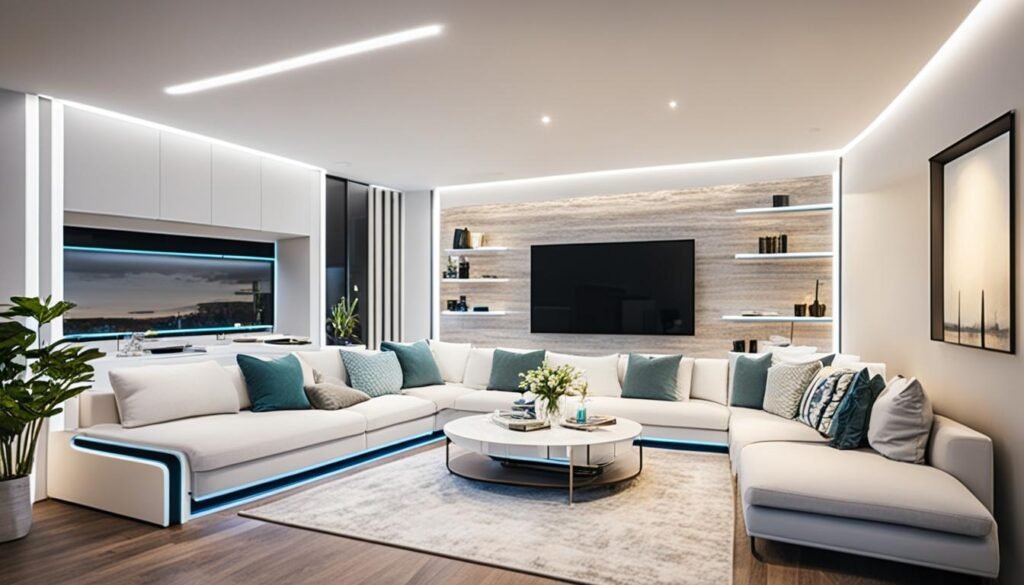
Connecting Multiple LED Strips
When you want to light up a big area or make special led strip light patterns, you’ll need to link several led strip light connectors. You can easily do this with LED strip connectors. They come in straight, angled, and flexible forms.4
To join the strips, push the end of one strip into the connector. Then do the same with another strip. Make sure they’re firmly connected.4 This lets you cover large areas with smooth led strip light connections. You could outline a headboard or highlight a TV perfectly.
Powering Your LED Strip Lights
It’s key to power your LED strip lights the right way for proper function and a long life. Start by finding out if your LED strips need 12V or 24V.5 Then, work out the total power they use. You do this by multiplying the wattage for each foot by the strip’s total length. Add 20% more for any power use changes.5
Determining Voltage Requirements
LED strips use either 12V or 24V power.5 It’s crucial to match the voltage of the strip to the power supply for them to work right.5
Calculating Power Consumption
Look at the product info to find out the wattage, which shows the power and consumption levels.5 The power supply should be slightly stronger than the LED strip uses. This helps adjust the power if needed.5 Using a weaker power supply can make your lights dim or not work at all.5
Selecting the Right Power Supply
LED power supplies change the voltage and current from mains to what your LED strips use.5 Most plug-in power supplies for LED strips will have a 2.1mm male connection. For the LED strips, they’ll have the female version. This makes it simple to connect.5 If you’re using a hardwired supply, you can connect it using a male screw-in-plug or wire nuts. To power multiple LED light strips together, you’ll need LED splitters.5 Doing this right ensures your LED strips light up as they should.5
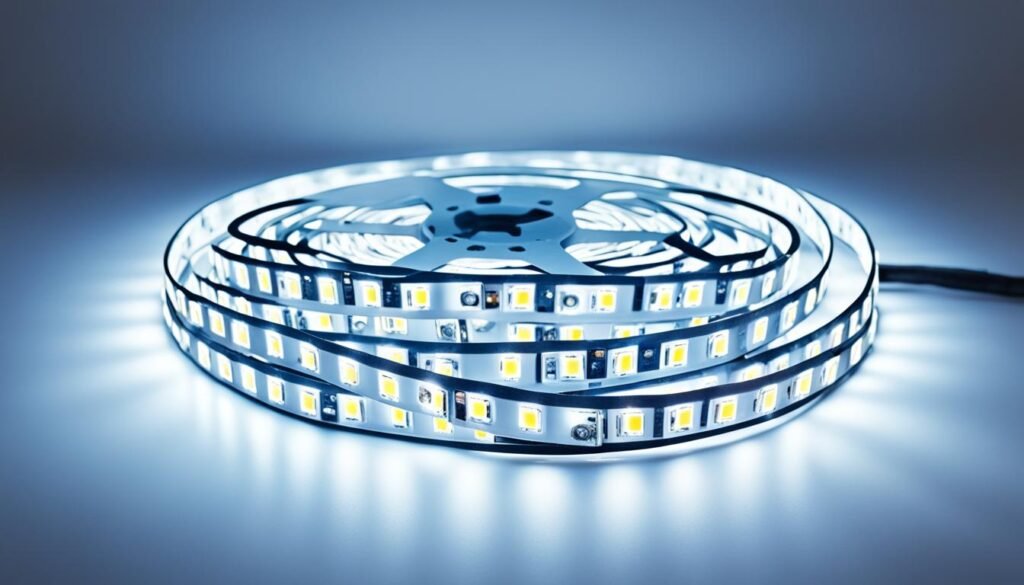
Conclusion
Setting up LED strip lights might look hard at first. But, with the right tools and information, it’s not that hard. By using the steps in this guide, your LED lights will look great and work safely.6 No matter where you put them, like your kitchen or staircase, LED strip lights make a big difference. Plus, they save a lot of energy. With some planning, you can enjoy them for a long time.
This guide explains everything from the types of LED strip lights to the power they need and the supplies you’ll need.6 Now, you know how to deal with LED strip light installation, wiring, and troubleshooting.78 Once you master setting them up, you can create amazing projects. You’ll find new ways to make your home look better and work smarter with these lights.
Now, you have all the info you need to use LED strip lights well. This can change your home or office into a better lit, energy-saving, and beautiful space. Let your creativity shine with LED lights and watch your space transform.
FAQ
What tools and materials are needed to properly connect LED strip lights?
How do I choose the right LED strip lights for my project?
How do I measure and trim the LED strip lights to fit my space?
How do I prepare the surface for applying the LED strip lights?
How do I apply the LED strip lights to the surface?
How do I connect multiple LED strips together?
How do I properly power my LED strip lights?
Check out our FREE Calculators on our Resources Page
Source Links
- https://hitlights.com/blogs/premium-led-strip-lighting/the-ultimate-guide-to-wiring-led-lights-tips-and-tricks
- https://www.wikihow.com/Install-LED-Strip-Lighting
- https://www.homedepot.com/c/ah/how-to-install-led-strip-lights/9ba683603be9fa5395fab9019b51ac0a
- https://www.waveformlighting.com/home-residential/connecting-led-strips-in-series-vs-parallel
- https://www.gindestarled.com/how-to-power-led-strips/
- https://www.elstarled.com/connecting-led-light-strips/
- https://onesmartlighting.com/blog/a-comprehensive-guide-to-cutting-customizing-and-connecting-led-strip-lights/
- https://stripsledlight.com/connecting-led-light-strips/

